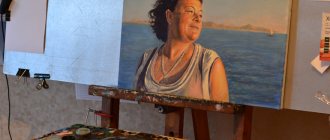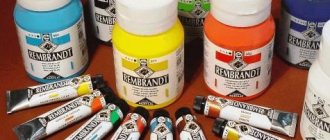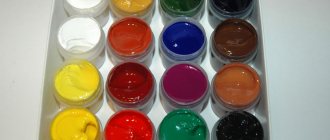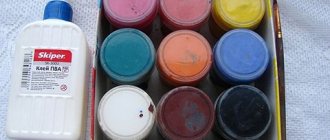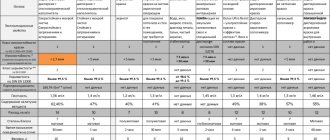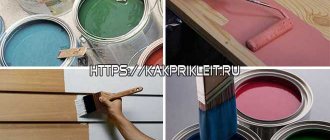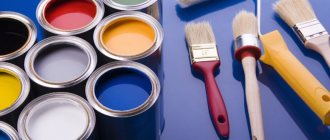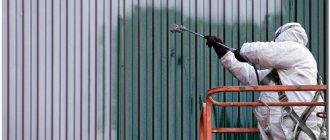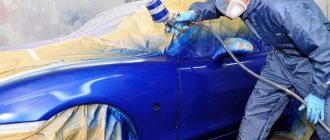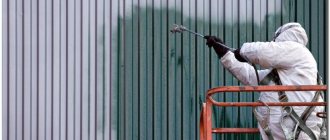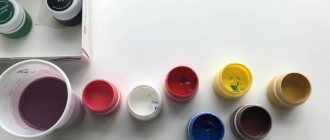What is gouache
Experts recommend starting to learn painting by using simple materials, which include gouache. It is easy to apply to any surface, including ceramics and fabric. To work, you only need a brush and water, no other aids.
1 / 3
Gouache is a water-soluble paint. It consists of coloring, finely ground pigments, white and adhesive binders. It belongs to opaque paints. It has a stronger color than watercolor.
1 / 3
The basis for creating gouache was watercolor, into which titanium white paint was introduced, which led to an increase in density. Painting with this paint has a specific feature - its pigment dries quickly, acquiring a lighter shade.
1 / 3
The properties of gouache allow you to eliminate any shortcomings. To do this, you need to wait for the previous layer to dry and apply the next one, correcting the errors.
1 / 5
Modern artists' opinions about gouache vary: some believe that it is children's paint. But in fact, it is an independent technique on a par with watercolor. With its help they create beautiful still lifes, portraits, landscapes.
Choosing a brush for painting with gouache
Brushes that are too soft are not suitable for working with gouache. For shading, backgrounds and fills when working with a damp brush, kolinsky, goat and synthetics are perfect.
For objects with a textured surface and when working with three-dimensional images, it is best to use a dry brush with hog bristles.
To depict a complex structure, you can also use a foam sponge, special rollers and ordinary paper napkins instead of a brush. With their help, you can achieve maximum realism by drawing the roughness of ceramic products or drawing a still life.
Origin of the term
The term gouache (from the French gouache, from the Italian guazzo “water paint, splash”) came from France, where it appeared in the 18th century, although the technique of gouache painting in European countries was known back in the Middle Ages. Gouache was originally a type of watercolor. To give a dense texture, white was added to water paints.
1 / 4
In the Middle Ages, glue was introduced into water-based pigments. Over time, artists learned experimentally that chalk powder and zinc white make the paint opaque and increase its density.
History of paint creation
Book miniatures in the Middle Ages were made using a combination of gouache and watercolor. The Renaissance is known for the use of gouache for various preparatory work, sketching, and making miniature portraits.
1 / 5
Gouache painting flourished in the Russian Empire in the 19th and early 20th centuries. It was during this period that painters from the World of Art organization used paint for decorations, posters, massive easel works, etc.
1 / 5
Gouache is made from pigments to which white and glue are added. White gives it a matte and velvety appearance, but when it dries, the color of the pigment becomes duller.
Types of gouache
Gouache is not a paint with universal properties. The basis of gouache remains the same, but the components in its various types differ, which create various effects.
1 / 3
Poster
1 / 3
This paint is used to make posters and theater decorations. It contains bright pigments and glue that ensures durability. It dries quickly. Thanks to the kaolin in the composition, the designs do not fade. Poster gouache is used to paint on canvas, plywood and cardboard.
Artistic
1 / 2
This type is classified as professional paints. With its help you can paint large-sized paintings. Its properties are matte velvety and high coverage. One stroke is enough to create a bright, rich color.
Acrylic
1 / 3
This type of gouache is not found as often as others, but it has completely unique properties. The paint can be applied to any surface, and the design comes out bright and durable, even mechanical damage is not a problem for it.
Fluorescent
1 / 2
The pigments introduced into the composition make the paints bright and impart glow properties under ultraviolet rays. Neon colors themselves glow in the dark. This type of paint must be applied to a white base, which is associated with low covering power.
Properties and features of gouache paint
The main advantage of gouache is its ability to evenly cover large surfaces with one shade, which makes this paint a favorite of many famous artists. Another advantage is the ability to correct an incorrect stroke by adding another layer of paint on top.
1 / 5
However, there are a number of disadvantages:
- When the paint dries, the main pigment becomes significantly lighter . To learn how to choose the right tone when drawing, you will have to spend a lot of time and effort.
- If you apply too thick a layer of paint, it will cause cracking and crumbling . An unsuccessful smear, corrected more than three times, will not take root.
Let's summarize
Advantages of gouache:
- Gouache dries quickly - this is convenient for editing and also for saving time.
- Versatility and simplicity. Gouache does not require special preparation of canvases, solvents or primers. You can write with it on wood, canvas, cardboard, paper.
- Density. Although many people don’t really like gouache, it’s probably better to start with it. Just to get used to working with thick paint. For some reason it’s easier to return to the diluted one.
- Price. Gouache is cheaper than acrylic and oil, but we wouldn’t recommend buying the cheapest one. It will be better to choose paint intended for artistic work than for student work. The difference between cheap and more expensive gouache can be colossal.
Flaws:
- As it dries it becomes lighter – in some cases very noticeable.
- It does not dissolve well in water - if you paint with heavily diluted gouache, you will be left with the impression of dirt in your work.
As you can see for yourself, there were more advantages. There are only two disadvantages to gouache, but they are significant. Artists have been using gouache in their work for several centuries, although, as a rule, for sketches. But in order to try your best, to feel the color, for certain decorative works, gouache is simply ideal.
Technicians
Gouache painting is distinguished by various drawing techniques.
Pastose technique
Characteristic of the technique is the application of undiluted thick strokes to the surface. Depending on the direction of the stroke, the texture will change. PVA glue added to the paint will help you achieve a better result. It will serve as a fastening element and will not allow the gouache to crack.
1 / 2
Light strokes should be applied first; after they have dried, the artist begins to paint with gouache with dark pigments. When the drawing is dry, take a special tool and scratch the top layer of paint with it to reveal the bottom one. The technique is reminiscent of engraving and allows you to create original textures.
Glaze
1 / 2
The “glaze” painting technique involves applying translucent layers of paint in several stages. The maximum permissible number of layers is 5. Moreover, each previous layer must dry before applying the next one. If you do not follow this rule, you will end up with a “dirty” color and the drawing will be ruined. Proper execution of the technique allows you to create complex tones and stunning pictures.
On wet
1 / 3
This technique is a habit for watercolor lovers. Its use involves diluting the paints with more water than usual. Several colors are applied to the paper, they begin to spread, acquiring interesting shapes. If this does not happen, it means the paint is not diluted with water enough. To avoid this, you can moisten the paper a little with water.
splashing
A simple method for creating texture. It is better to spray paint using a small paint brush. It is dipped into the paint, with the bristles being pulled away from the painting and then suddenly released. A cloud of small drops of paint is sprayed. The part of the picture that should not be splashed should be covered with another sheet of paper.
1 / 3
You can also highlight “wet on dry”, “dry brush”, graininess, etc.
Still life drawing
This is a more difficult task. The artist will need some skill, the lack of which, however, he can compensate with diligence. We need to create a small composition.
You can use all available materials, household items (liks, pots, glasses), food (fruits and vegetables are perfect). You can place them on a tray, a piece of cloth, or simply place them against the wall.
In this case, each of the objects should be in front or behind the others. Of course, it will be much more difficult to draw this way, but also more interesting. The sketch cannot be neglected; it is more necessary than ever.
First you need to draw the outlines of the background, if, for example, the fabric is slightly curved, has folds, or wallpaper with a pattern. Draw objects located in the back, then in the front. This will help you maintain perspective and avoid minor mistakes.
The sketch needs to be carefully worked out. Adults can try to convey the convexity of objects using paint in different shades. Make the places where the rays fall lighter, the shadow areas darker. The child does not need these details.
How is it different from watercolor?
On the palette and in appearance, gouache is similar to watercolor. However, its behavior during work is more reminiscent of oil or acrylic. Watercolor works are transparent, they show a transition from light to dark. The name of this paint contains the word “aqua”, that is, water. The main properties are softness and fluidity. Watercolor paintings turn out tender and airy.
1 / 3
Gouache also contains water, but this paint has completely different properties. Gouache works are created by applying opaque brushstrokes to the canvas. Density allows you to apply lighter tones to darker strokes. Using this paint, it is easy to correct errors in the painting; it is quite simple to apply a new stroke over the old one.
1 / 3
Thus, gouache differs from watercolor in the density of application. If watercolor is watery and light, then gouache is rich and dense.
How to create a background for gouache?
Two methods are used to draw the background:
- The artist makes a pencil sketch and then fills in the outlines, starting with the dark elements. The contour is filled without pressing from the edge to the center, then from the center to the other edge. The consistency of thin sour cream can serve as a guide to determining the desired thickness of paint. This method is suitable for working with a small pattern.
- If the surface is large, then it is better to use the filling method, when the background is painted first, and only then the details are drawn. Most often, the background consists of two or three colors. For a landscape, for example, the color of the sky is used in the upper part of the picture, the color of the earth in the lower part, and the lightest stripe is applied in the middle. Then, before the paint dries, the background is smoothed with a wide, damp brush, continuously from left to right, moving from the bottom of the picture to the top. After this, the brush is wetted again and the paint is smoothed, moving vertically from top to bottom. This method may seem quite complicated, but this is the only way the gouache painting will have an even and beautiful background. Next, details of the landscape (for example, hills) are drawn on the still wet background, and after the paint has dried, vegetation, clouds and other planned elements of the composition are painted. For convenience, the paper should be well secured to the tablet.
History of painting
The art of gouache took its initial steps during the times of medieval book miniatures. Painters from Asia and Europe created extraordinary illustrations by adding whitewash to watercolors.
1 / 3
The Renaissance is characterized by the use of gouache in the creation of frescoes and sketches of paintings. In the 16th-17th centuries, portrait art began to develop. This led to the fact that miniature portraits were painted with it on various materials.
1 / 3
In the 18th-19th centuries, combining gouache with watercolor, the authors of paintings ensured that their works looked realistic and expressive. In the middle of the 19th century, factory gouache began to be actively produced. It is at this time that gouache paints acquire their basic properties: thickness, dullness, etc.
1 / 3
At the end of the 19th and beginning of the 20th centuries, great painters actively worked with gouache, using it to create full-fledged works of art. In Russia, the gouache technique reaches a high level of development. During this period, gouache paintings by famous artists such as V.A. Serov, A.Ya. Golovin, A.Ya. Benois and others appeared.
Master class: painting with gouache
A simple example of how to make a real picture (winter tree) step by step:
- You should start with the background - snow, sky. In the area where there will be a tree, you need to make the sky brighter.
- After drying the background, draw a tree with branches with a pencil. Then draw the contours with paint, drawing well the trunk, brown branches, making them white with snow at the tips. More small branches should be drawn on the main branches.
- Make details. To do this, lighten the small branches and “strengthen” the trunk with dark brown, black gouache. Add gray shadows to the branches.
- To create a brighter picture, you can add pink and blue to the background - like shades of the sky.
To decorate the picture, you can also draw animals, birds, a garland - whatever your imagination suggests. Gouache will quickly become your favorite material for creativity, because working with it is easy and fun!
Russian artists who painted in gouache
Boris Mikhailovich Kustodiev (1878 - 1927)
The work of Boris Kustodiev is distinguished by his love for the portrait genre - paintings in which the surrounding landscape or interior reveals the character of the hero. His paintings are bright and cheerful. For everyday scenes of a decorative and entertaining nature.
1 / 8
The works of this artist radiate health, joy and love of life, regardless of the period in which they were painted. Among the famous paintings painted: “Portrait of Fyodor Chaliapin”, “Maslenitsa”, “Fair”
Kazimir Severinovich Malevich (1879 - 1935)
1 / 6
Russian avant-garde artist, art theorist, founder of Suprematism. Malevich challenged academic art, experimented in his paintings, combining incompatible things. Malevich's work was constantly changing and developing; he tried all the directions and styles that arose at the turn of the 19th and 20th centuries. Among the famous paintings: “Bather”, “Self-Portrait”, “Head of a Peasant”.
Sudeikin Sergey Yurievich (1882 - 1946)
1 / 5
Russian painter who classified himself as symbolic painting. His paintings are permeated with theatricality, farce, which echoes tragedy. Sergei Sudeikin depicted his characters in sharp poses, using bright colors. Among the famous paintings: “Venetian Dolls”, “Lovers by Moonlight”.
Vsevolod Andreevich Filippov (1893 –1976)
1 / 8
The main themes of the artist Vsevolod Filippov are Russian nature, Russian architecture, and the history of Rus'. His paintings were first presented at a personal exhibition in 1955. The world recognized Vsevolod Andreevich as a subtle landscape painter and master with a unique style. Famous paintings: “Sunset”, “Streams Run”, “Moscow Courtyards”, etc.
Valentin Aleksandrovich Serov (1965-1911)
1 / 7
Valentin Serov’s paintings are characterized by a light, “sunny” intonation. The artist tried to convey in painting everything that pleases the human eye. The portraits painted by Serov are distinguished by their amazing similarity, while at the same time very accurately emphasizing the character traits of the hero. His later works demonstrate the artist's versatility, as he is not limited by the stereotypes of any school. Famous paintings: “The Model”, “In Winter”, “The Rape of Europa”.
What types of interior painting are there?
If you start looking for examples of interior painting on the Internet, you will most likely first be confused by the variety and types of options offered.
And also, very often, beautiful paintings complement beautiful and rich interiors, luxurious houses and apartments, which, let’s be honest, not everyone has. It is unlikely that the average city apartment is decorated in the Baroque, Classicism or Art Nouveau style, into which many types of interior paintings fit.
But how can this be? How to choose the right type of interior painting for you? Find out which ones are available and which types suit which interior!
I talk about this in as much detail as possible in my FREE master class “The first step in interior painting.” At the master class, together we will paint a painting “Forest” that WILL SUIT ANY INTERIOR, and after the master class I will give you an additional lesson on drawing an interior painting “Bull”. You can sign up for the master class using the link - https://nyschool.ru/mk_les?utm_source=seo&utm_medium=blog&utm_campaign=allseo
Reproductions of famous paintings
One type of painting for the interior can be some reproductions of paintings. Moreover, these can be both modern works and recognized masters of classical painting.
The main thing is to choose the appropriate frame for such a picture. Well, in general, it should match the style of the room. After all, if you want to decorate, for example, a children's room, then you obviously will not place a painting by Gustav Klimt in it.
Posters
Posters are printed products, but despite the fact that they are not made of paint, they can fit very beautifully and organically into your interior. Posters, as a rule, are very often large in size, so you should carefully choose the design on it.
Modular pictures
This is a composition consisting of several canvases on which one painting is depicted. This painting in the abstract genre looks very beautiful. The number of canvases may vary, but more often, these are 2-4 canvases of different sizes, which are placed on the wall both symmetrically and asymmetrically.
Below I will write separately about each type of painting and give examples of which paintings you can take as references and paint at home yourself. By the way, if you are a beginner, be sure to read the next section.
Gouache masterpieces
1 / 10
